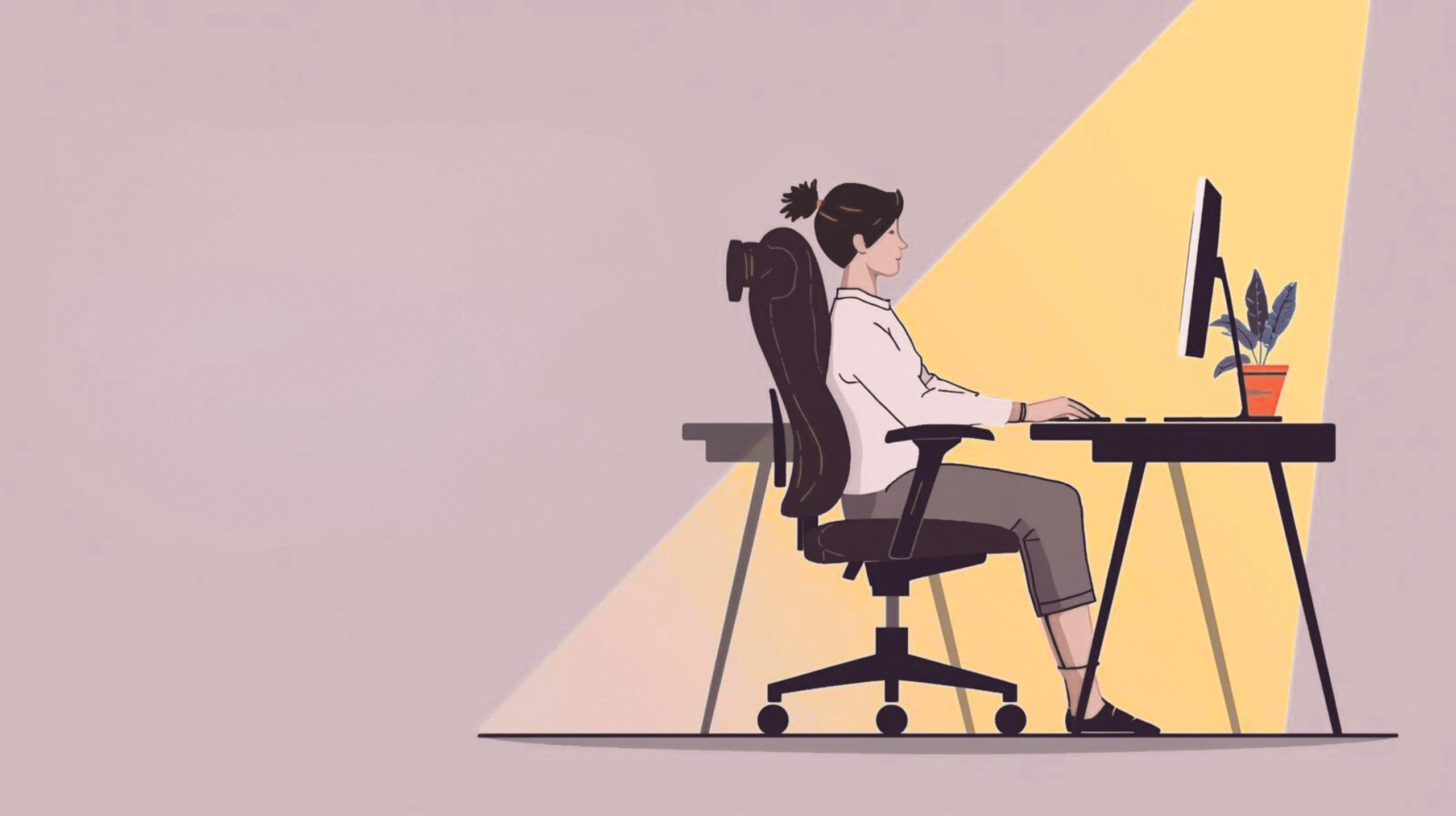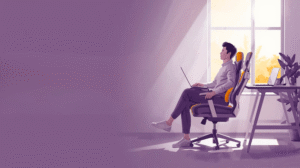Modern work culture often demands sitting for hours—whether at a desk, in meetings, or while working from home. Unfortunately, long periods of sitting take a toll on your body. Back pain, stiffness, tailbone discomfort, and poor posture are among the most common complaints of office workers, gamers, and even students.
Our bodies are designed for movement, not prolonged sitting. When you stay seated for extended periods, the pressure on your spine increases, circulation decreases, and muscles that support your posture begin to fatigue. Over time, this leads to slouching, chronic pain, and reduced productivity.
An office chair cushion for long sitting offers a practical, science-backed solution. These cushions are specially designed to enhance comfort, support spinal alignment, and relieve pressure on sensitive areas like the lower back and tailbone. Whether you work at a desk all day or drive long distances, the right cushion can make a remarkable difference in your comfort and long-term health.
This article explores how office chair cushions work, their types, benefits, how to choose the right one, and tips for using them effectively.
Why Long Sitting Causes Discomfort
1. Pressure and Posture Issues
When sitting for long periods, the lumbar spine (lower back) bears most of your body’s weight. Standard office chairs often lack sufficient lumbar or tailbone support, leading to uneven pressure distribution. This pressure compresses the spinal discs, causes muscle strain, and restricts blood flow to the hips and legs.
Moreover, as fatigue sets in, people naturally begin to slouch or lean forward, further stressing the lower back and neck. Over time, these posture issues contribute to chronic pain, stiffness, and even long-term spinal misalignment.
2. Signs You Need a Cushion
It’s easy to ignore discomfort until it becomes a daily problem. Common signs you might need an ergonomic chair cushion include:
- Lower back or tailbone pain after long sitting sessions
- Numbness or tingling in the legs or hips
- Difficulty maintaining upright posture without back support
- Feeling fatigued or restless after sitting for only short periods
- Noticeable slouching or rounding of the shoulders
These symptoms indicate that your body isn’t receiving adequate support while seated.
3. Ergonomics and Spinal Health
Ergonomics focuses on designing tools and workspaces that fit human needs and movements. When your chair and cushion work together ergonomically, the result is less strain on muscles and joints and improved spinal alignment.
An ergonomic office chair cushion distributes your body weight evenly, supports the natural S-curve of the spine, and promotes proper sitting posture. This minimizes stress on the lower back and pelvis, helping prevent musculoskeletal issues and improving comfort throughout the workday.
What Is an Office Chair Cushion for Long Sitting?
An office chair cushion is a specially engineered support pad designed to enhance sitting comfort during extended hours. It provides lumbar and tailbone support, improves posture, and helps alleviate discomfort caused by prolonged sitting.
These cushions come in various shapes, materials, and designs, each targeting specific needs—from general comfort to orthopedic relief.
Types of Cushions
1. Memory Foam Cushions
Memory foam adapts to your body’s contours, distributing weight evenly and relieving pressure points. High-density memory foam offers lasting support while maintaining softness for comfort. It’s ideal for those who sit for extended hours and want personalized comfort.
2. Gel-Infused Cushions
Gel cushions are perfect for those who experience heat buildup or discomfort. The gel layer provides cooling relief and helps regulate temperature while reducing pressure points. Many hybrid cushions combine memory foam with gel for optimal comfort and durability.
3. Orthopedic Cushions
Designed by healthcare professionals, orthopedic cushions support individuals with chronic back, coccyx, or sciatic pain. They typically feature a U-shaped or cut-out design that relieves tailbone pressure and maintains spinal alignment.
4. Wedge-Shaped Cushions
Wedge cushions slightly tilt your pelvis forward, encouraging a natural upright posture. They promote better spinal alignment and reduce slouching, making them excellent for office or home use.
Benefits of Using an Office Chair Cushion
1. Posture Support and Spinal Alignment
The most important benefit of an office chair cushion is improved posture. Cushions with lumbar or contoured designs support the spine’s natural curvature, helping you sit upright and preventing slouching. Over time, this reduces the risk of chronic back and neck pain.
2. Pain Relief
A well-designed cushion alleviates pain by reducing pressure on sensitive areas such as the coccyx, hips, and lumbar spine. This is especially beneficial for individuals suffering from sciatica, herniated discs, or tailbone injuries.
3. Comfort and Productivity
Comfort directly impacts focus and efficiency. Sitting comfortably helps maintain concentration, reduces restlessness, and enhances overall work performance. When physical discomfort is minimized, mental energy is preserved for productive tasks.
4. Long-Term Health Benefits
Consistent use of ergonomic cushions supports spinal health and prevents musculoskeletal disorders. By improving posture and circulation, these cushions contribute to better long-term back health and reduced risk of degenerative spinal issues.
5. Versatile Usage
Office chair cushions aren’t limited to office use. They’re versatile enough for gaming chairs, wheelchairs, car seats, and home chairs—making them a valuable accessory for anyone who spends significant time sitting.
How to Choose the Right Cushion
Choosing the right office chair cushion depends on your body type, chair design, and comfort needs. Here are key factors to consider:
1. Material and Firmness
- Memory Foam: Offers adaptive support and pressure relief.
- Gel Cushions: Provide cooling and balanced firmness.
- Hybrid Models: Combine both for comfort and temperature regulation.
Select a cushion with medium-to-high firmness—too soft can lead to sinking, and too firm may feel uncomfortable over time.
2. Design and Ergonomics
- Contoured Cushions: Support the natural shape of your spine and pelvis.
- Tailbone Cutout (U-Shape): Relieves coccyx pressure for tailbone pain relief.
- Wedge-Shaped: Promotes forward pelvic tilt for upright posture.
3. Size and Compatibility
Ensure the cushion fits your chair properly. A cushion that’s too large or small can reduce stability or comfort. Portable cushions are ideal if you move between office, home, or car environments.
4. Additional Features
Look for:
- Removable, washable covers for hygiene.
- Non-slip bottoms to prevent sliding.
- Adjustable straps for secure attachment.
- Inflatable or adjustable models for personalized comfort.
Investing in a high-quality cushion with these features ensures durability and convenience.
Proper Use and Maintenance
Using your office chair cushion correctly is crucial for maximum benefit.
How to Use
- Align the cushion so that its curve supports your lumbar spine or tailbone, depending on the design.
- Adjust your chair’s height and backrest for ergonomic posture.
- Make sure both feet rest flat on the floor with knees at a 90-degree angle.
- Use anti-slip straps or backing to keep the cushion stable.
Maintenance Tips
- Wash removable covers regularly to prevent sweat buildup and bacteria.
- Avoid exposing foam to direct sunlight or moisture, as it can degrade material quality.
- Replace cushions every 1–2 years for optimal support—memory foam gradually loses resilience over time.
Proper care ensures hygiene, longevity, and continued comfort.
Complementary Habits for Long-Term Comfort
A cushion alone can’t fix posture or prevent all pain—it works best alongside healthy habits.
1. Adjust Your Workstation
Set up your workstation ergonomically:
- Keep your monitor at eye level.
- Adjust chair height so elbows form a 90-degree angle.
- Use footrests if necessary for additional support.
2. Take Regular Breaks
Even with a cushion, sitting too long is unhealthy. Take short standing or stretching breaks every 30–60 minutes. Walk around or do simple back and shoulder stretches to improve circulation.
3. Strengthen Core and Back Muscles
Incorporate exercises like planks, bridges, or yoga to strengthen your core and back. Strong muscles better support your posture and reduce dependency on external supports.
4. Practice Posture Awareness
Make a conscious effort to sit tall with your shoulders relaxed and spine aligned. Over time, this habit becomes second nature and complements the benefits of your ergonomic cushion.
Conclusion
Sitting for long hours is almost unavoidable in today’s lifestyle, but discomfort and pain don’t have to be. An office chair cushion for long sitting is a simple yet powerful tool for improving comfort, posture, and productivity.
By choosing the right cushion—whether memory foam, gel, or orthopedic—and pairing it with good sitting habits, you can protect your spine, reduce fatigue, and work more efficiently. Over time, you’ll notice improved energy levels, fewer aches, and better focus.
Investing in your sitting comfort isn’t a luxury—it’s a commitment to your health and long-term well-being.
Frequently Asked Questions:
1. What is an office chair cushion for long sitting, and how does it help my back?
An office chair cushion provides ergonomic support to reduce pressure on your lower back, hips, and tailbone. It helps maintain spinal alignment, improves posture, and prevents muscle fatigue, making long sitting hours more comfortable and healthy.
2. Which type of cushion is best for extended sitting hours?
For most people, a high-density memory foam or gel-infused cushion works best. Memory foam contours to your body shape, while gel cushions keep you cool and distribute pressure evenly. If you suffer from chronic pain, an orthopedic or wedge cushion is ideal.
3. Can a cushion relieve chronic lower back or tailbone pain?
Yes. Orthopedic and coccyx cushions are designed to relieve tailbone pressure and support the lumbar spine, which can ease chronic pain caused by poor posture, sciatica, or long sitting durations.
4. How should I position a cushion for maximum support?
Place the cushion so that the cutout aligns with your tailbone (for coccyx cushions) or the curved part fits into your lower back (for lumbar cushions). Keep your back straight, shoulders relaxed, and feet flat on the floor for proper ergonomic alignment.
5. Are gel cushions better than memory foam cushions?
Both have unique benefits. Gel cushions provide cooling comfort and are great for heat-sensitive users, while memory foam cushions offer superior contouring and long-term pressure relief. A hybrid model combining both materials delivers the best of both worlds.
References
- American Chiropractic Association. (2023). Sitting and spinal health: Ergonomic best practices. https://www.acatoday.org/news-publications/sitting-and-spinal-health/
- Mayo Clinic. (2024). Tips for proper posture while sitting. https://www.mayoclinic.org/healthy-lifestyle/adult-health/in-depth/posture/art-20046066
- National Institutes of Health. (2022). Ergonomics and musculoskeletal disorders. https://www.niehs.nih.gov/health/topics/agents/ergonomics/index.cfm
- Occupational Safety and Health Administration. (2024). Workplace ergonomics guidelines. https://www.osha.gov/ergonomics
- Spine-health. (2024). Benefits of lumbar support and ergonomic seating. https://www.spine-health.com/wellness/ergonomics/lumbar-support-office-chairs



















